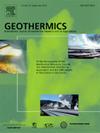New insight into the shallow sub-surface for geothermal prospection of Puga valley, Ladakh, India from electrical resistivity tomography
IF 3.9
2区 工程技术
Q3 ENERGY & FUELS
引用次数: 0
Abstract
The Puga valley in Ladakh, India, is one of the most significant geothermal fields in the Himalayan belt, marked by extensive hot springs with enriched mineralisation. This study applies a dense coverage of Electrical Resistivity Tomography (ERT) data to investigate the subsurface geological features, structural controls, and hydrogeological conditions influencing geothermal fluid dynamics. In the present study, ten ERT profile results across the valley were analysed, revealing low-resistivity anomalies (<1 to 10 Ω.m) associated with geothermal fluid pathways, particularly in the eastern zone. In contrast, high-resistivity zones (400 – 2500 Ω.m) in the western part of the Puga valley represent compact hard rocks and shallow basement structures of the Tso Morari Crystalline. Two distinct fluid-saturated zones are identified from the ERT model results. The first zone lies parallel to the ground, typically at a shallow level of around 20–30 m. The second fluid-saturated zone delineates a fault structure, as fluid conduits from the near surface zone to as deep as 140 m. Additionally, the 3D resistivity model reveals an ENE-WSW trending linear conductive body on the eastern side of the valley. In contrast, a resistive body, the Tso Morari Crystalline, dominates the western part of the valley. Based on these observations, three potential sites are identified for exploratory drilling for future exploitation of the geothermal resources. These findings provide crucial insights for geothermal energy exploration from the geological and structural understanding as well as the futuristic perspective in Puga valley, highlighting the efficacy of ERT mapping for geothermal prospecting.
利用电阻率层析成像技术对印度拉达克Puga山谷浅层地热勘探的新认识
印度拉达克的普加山谷是喜马拉雅带最重要的地热田之一,以丰富的矿化温泉为标志。本研究采用密集覆盖的电阻率层析成像(ERT)数据来研究地下地质特征、构造控制和影响地热流体动力学的水文地质条件。在本研究中,对整个山谷的10个ERT剖面结果进行了分析,揭示了与地热流体通道相关的低电阻率异常(<;1至10 Ω.m),特别是在东部地区。而Puga山谷西部的高电阻率带(400 ~ 2500 Ω.m)代表了致密的硬岩和浅基底结构的Tso Morari晶体。根据ERT模型的结果,确定了两个不同的流体饱和区。第一个区域与地面平行,通常位于约20-30米的浅层。第二个流体饱和带描绘了一个断层结构,流体从近地表传导至140 m深处。此外,三维电阻率模型显示,峡谷东侧呈ENE-WSW向线性导电体。与之形成鲜明对比的是,在山谷的西部,有一个叫做左莫拉里水晶的抵抗体。根据这些观测结果,确定了三个潜在的地热资源勘探钻探地点。这些发现为Puga山谷的地热能勘探提供了重要的见解,从地质和构造的认识以及未来的角度来看,突出了ERT测绘在地热勘探中的有效性。
本文章由计算机程序翻译,如有差异,请以英文原文为准。
求助全文
约1分钟内获得全文
求助全文
来源期刊

Geothermics
工程技术-地球科学综合
CiteScore
7.70
自引率
15.40%
发文量
237
审稿时长
4.5 months
期刊介绍:
Geothermics is an international journal devoted to the research and development of geothermal energy. The International Board of Editors of Geothermics, which comprises specialists in the various aspects of geothermal resources, exploration and development, guarantees the balanced, comprehensive view of scientific and technological developments in this promising energy field.
It promulgates the state of the art and science of geothermal energy, its exploration and exploitation through a regular exchange of information from all parts of the world. The journal publishes articles dealing with the theory, exploration techniques and all aspects of the utilization of geothermal resources. Geothermics serves as the scientific house, or exchange medium, through which the growing community of geothermal specialists can provide and receive information.
 求助内容:
求助内容: 应助结果提醒方式:
应助结果提醒方式:


